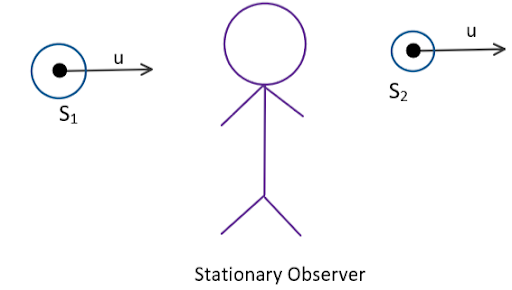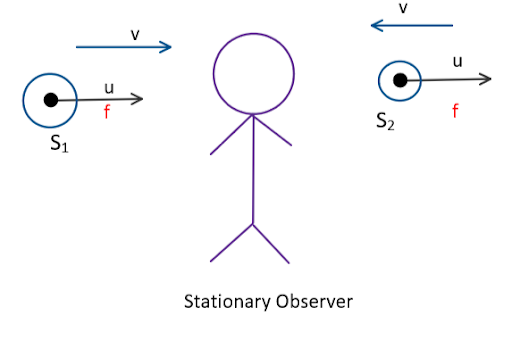
Two sources ${S_1}$ and ${S_2}$ of same frequency $f$ emit sound. The sources are moving as shown in figure 1 with speed $u$each. A stationary observer hears that sound. The beat frequency is? ( $v = 0$ velocity of sound)

A. $\dfrac{{2{v^2}f}}{{{v^2} - {u^2}}}$
B. $\dfrac{{2u}}{v}f$
C. $\dfrac{{2{u^2}f}}{{{v^2} - {u^2}}}$
D. $\dfrac{{2uvf}}{{{v^2} - {u^2}}}$
Answer
216.3k+ views
Hint: In the case of a problem based on wave phenomena, we know that all the parameters such as i.e., frequency, amplitude, time period, etc., vary with each other in some way hence, analyze every option given in this question and use mathematical calculation by finding the apparent frequency of both the sources with the information given.
Formula used:
The expression of apparent frequency (${f_1}$) of source ${S_1}$ is,
${f_1} = f\left( {\dfrac{{v - 0}}{{v - u}}} \right) = \dfrac{v}{{v - u}}f$
Here, $v$ is the velocity of sound and $u$ is the velocity of source.
Complete step by step solution:
Two Sources ${S_1}$ and ${S_2}$ of the same frequency $f$ emit sound (given) and these sources are moving in the same direction as shown in figure 2. The velocity of the two sources is again same i.e., $u$(given). And, velocity of sound $v = 0$ (given). As the observer is stationary, therefore, the direction of sound waves must be opposite in direction as shown in figure 2.

Now, Apparent frequency of source ${S_1}$ will be:
${f_1} = f\left( {\dfrac{{v - 0}}{{v - u}}} \right) = \dfrac{v}{{v - u}}f$ … (1)
And, Apparent frequency of source ${S_2}$ will be:
${f_2} = f\left( {\dfrac{{v - 0}}{{v + u}}} \right) = \dfrac{v}{{v + u}}f$ … (2)
We know that Beat Frequency $f'$ can be calculated as:
$f' = {f_1} - {f_2}$
Substitute the values of ${f_1}$ and ${f_2}$ in the above expression, we get
$f' = \dfrac{v}{{v - u}}f - \dfrac{v}{{v + u}}f$
Taking $vf$common, we get
$f' = vf\left( {\dfrac{{v + u - (v - u)}}{{(v - u)(v + u)}}} \right)$
$\Rightarrow f' = vf\left( {\dfrac{{2u}}{{{v^2} - {u^2}}}} \right)$........(Because, ${a^2} - {b^2} = (a - b)(a + b)$)
Thus, according to the given question, the beat frequency for the two sources is $\dfrac{{2uvf}}{{{v^2} - {u^2}}}$.
Hence, the correct option is D.
Note: Since this is a conceptual-based problem on wave and acoustics hence, it is essential that given sources and their conditions must be analyzed very carefully to give a precise explanation of the solution. While writing an answer always remember to use the mathematical proven relations to provide an accurate solution.
Formula used:
The expression of apparent frequency (${f_1}$) of source ${S_1}$ is,
${f_1} = f\left( {\dfrac{{v - 0}}{{v - u}}} \right) = \dfrac{v}{{v - u}}f$
Here, $v$ is the velocity of sound and $u$ is the velocity of source.
Complete step by step solution:
Two Sources ${S_1}$ and ${S_2}$ of the same frequency $f$ emit sound (given) and these sources are moving in the same direction as shown in figure 2. The velocity of the two sources is again same i.e., $u$(given). And, velocity of sound $v = 0$ (given). As the observer is stationary, therefore, the direction of sound waves must be opposite in direction as shown in figure 2.

Now, Apparent frequency of source ${S_1}$ will be:
${f_1} = f\left( {\dfrac{{v - 0}}{{v - u}}} \right) = \dfrac{v}{{v - u}}f$ … (1)
And, Apparent frequency of source ${S_2}$ will be:
${f_2} = f\left( {\dfrac{{v - 0}}{{v + u}}} \right) = \dfrac{v}{{v + u}}f$ … (2)
We know that Beat Frequency $f'$ can be calculated as:
$f' = {f_1} - {f_2}$
Substitute the values of ${f_1}$ and ${f_2}$ in the above expression, we get
$f' = \dfrac{v}{{v - u}}f - \dfrac{v}{{v + u}}f$
Taking $vf$common, we get
$f' = vf\left( {\dfrac{{v + u - (v - u)}}{{(v - u)(v + u)}}} \right)$
$\Rightarrow f' = vf\left( {\dfrac{{2u}}{{{v^2} - {u^2}}}} \right)$........(Because, ${a^2} - {b^2} = (a - b)(a + b)$)
Thus, according to the given question, the beat frequency for the two sources is $\dfrac{{2uvf}}{{{v^2} - {u^2}}}$.
Hence, the correct option is D.
Note: Since this is a conceptual-based problem on wave and acoustics hence, it is essential that given sources and their conditions must be analyzed very carefully to give a precise explanation of the solution. While writing an answer always remember to use the mathematical proven relations to provide an accurate solution.
Recently Updated Pages
JEE Atomic Structure and Chemical Bonding important Concepts and Tips

JEE Amino Acids and Peptides Important Concepts and Tips for Exam Preparation

Electricity and Magnetism Explained: Key Concepts & Applications

Chemical Properties of Hydrogen - Important Concepts for JEE Exam Preparation

JEE Energetics Important Concepts and Tips for Exam Preparation

JEE Isolation, Preparation and Properties of Non-metals Important Concepts and Tips for Exam Preparation

Trending doubts
JEE Main 2026: Application Form Open, Exam Dates, Syllabus, Eligibility & Question Papers

Derivation of Equation of Trajectory Explained for Students

Hybridisation in Chemistry – Concept, Types & Applications

Understanding the Angle of Deviation in a Prism

Understanding Collisions: Types and Examples for Students

How to Convert a Galvanometer into an Ammeter or Voltmeter

Other Pages
JEE Advanced Marks vs Ranks 2025: Understanding Category-wise Qualifying Marks and Previous Year Cut-offs

Units And Measurements Class 11 Physics Chapter 1 CBSE Notes - 2025-26

NCERT Solutions For Class 11 Physics Chapter 8 Mechanical Properties Of Solids

Motion in a Straight Line Class 11 Physics Chapter 2 CBSE Notes - 2025-26

NCERT Solutions for Class 11 Physics Chapter 7 Gravitation 2025-26

Ideal and Non-Ideal Solutions Explained for Class 12 Chemistry




